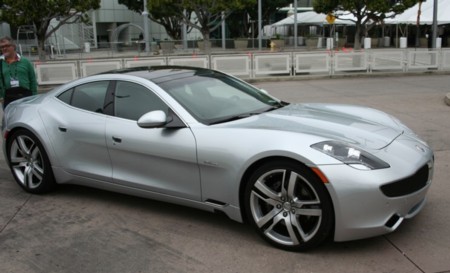






2012 Blog Archive
![]() About
EVFinder
About
EVFinder ![]() EVents Calendar
EVents Calendar
![]() FAQ
FAQ ![]() EV Selector
EV Selector ![]() Links
Links
![]() The EV Finder Archive
The EV Finder Archive ![]() Site
Map
Site
Map
Sunday Dec 30, 2012 – Trouble at Coda
Sunday Dec 23, 2012 – Tesla Profitability
Sunday Dec 16, 2012, 2012 – Fisker’s Troubles
![]() Follow evfinder.com on Twitter
Follow evfinder.com on Twitter
Sunday Dec 30, 2012 – Trouble at Coda – I was on Prius Chat earlier this week reviewing a thread about charging at Century City Shopping Center here in LA and someone made a comment that the six Coda installed J1772 chargers had been removed. Someone also mentioned that the Coda Experience Center had been shut down.
On Thursday night my wife and I stopped by the Mall and I was able to confirm that the chargers had been removed. There were still a couple of Coda Sedans parked in two of the spaces but three of the other spaces had reverted to regular parking spots. On Saturday I parked in one of these spaces and when I returned to the parking about 1pm the two Sedans had gone.
 Further
research showed that things were not going well for Coda. They have sold less
than 100 sedans since they went on sale in March. This isn’t that surprising
since the car, which they are only selling through 4 dealerships, is priced
about the same as the Nissan Leaf and Ford Focus EV, both mainstream automotive
manufactures.
Further
research showed that things were not going well for Coda. They have sold less
than 100 sedans since they went on sale in March. This isn’t that surprising
since the car, which they are only selling through 4 dealerships, is priced
about the same as the Nissan Leaf and Ford Focus EV, both mainstream automotive
manufactures.
To add to their woes the NHTSA issued a recall that affected 78 of their vehicles because of a faulty side curtain airbag that may not deploy properly. Adding to the pain the NHTSA released their crash test ratings for the Coda Sedan and while it scored 5 stars in side impact, rear impact, and rollover tests it only managed 2 stars in the front impact test for an overall rating of 4 stars.
The result of these two actions by the NHTSA has been to slow Coda sales to almost nothing. In addition Coda has been trying to raise $150 million in capital but reportedly only managed to get $21.5 million.
On December 11 Brad Berman at plugincars.com broke the news of layoffs at Coda Automotive. According to plugincars.com Forrest Beanum from Coda responded with the following statement. “CODA has released approximately 50 employees or 15% of our workforce across all functions to streamline our operations and right-size the Company. The Company is taking this action to better position our business going forward. We remain committed to the continued development and distribution of our products."
It seems that CODA laid-off a good number of their sales and marketing staff including the folks working at the experience center in Century City. It also appears that they let go most of the engineers working on their next generation vehicle.
The whole situation does not look good for CODA. The poor crash test performance in frontal impact, added to the car’s dated look, are likely to mean very few sales. Even the bigger battery capacity and resulting longer range is unlikely to lure buyers away from more established makes like the Nissan Leaf and Ford Focus EV. The tiny dealer network, and the idea of selling only in California, is also going to be a big drawback.
Things are looking pretty bleak for CODA Automotive as a viable maker of electric cars. Unless they can manage some hefty fleet sales in the near future it seems unlikely that they will be able to continue marketing the car.
CODA does have other things to fall back on. They have a technology partnership with a battery company based in China that could make them a major player in the grid storage market space.
I’ve said this plenty of times in the past, starting up a viable car company is very difficult. That’s why the young kid on the block when it comes to major car makers is 72 years old. It takes a lot of capital, a lot of know-how, and a lot of hard work to get a car onto the market, sell it in volume, and grow the business. It is not surprising to see these start-ups fail.
CODA may continue to produce and sell a small number of CODA sedans but it seems unlikely now that they will ever become a volume manufacturer without a major cash infusion.
Sunday Dec 23, 2012 – Tesla Profitability – Earlier this month Elon Musk tweeted to his followers that the company had been cash flow positive for the previous week. This is the first time that Tesla has been cash flow positive since back in 2009 when it was delivering the Roadster.
While this is a minor triumph for the company, and there is lots of work ahead to maintain profitability, the news is nevertheless very good for Tesla Fans.
After pointing out that production for 2013 was already sold out in an interview last week with Bloomberg, Mr. Musk went on to say that the company should become profitable in 2013 as production ramps up.
The Bloomberg interview showed the media hostility toward electric cars. In their opening they talked about sales of the Tesla roadster being “Sluggish” and sales of “only 1,800 cars worldwide”. The first thing Elon Musk did was to point out that the Roadster had always been a limited production car and that sales were actually better than expected. He didn’t correct their sales numbers but by my count Tesla have sold a total of 2,500 Roadsters.
They also kept trying to compare them to Chinese automaker BYD which made Mr Musk laugh. He was obviously trying not to trash the BYD vehicles but anyone who knows anything about that company will know that they are about as different from Tesla as you can get.
He also said something I thought was very significant. He mentioned that the almost no parts were sourced from China. The reason he gave was that the Chinese parts were about 5-10% more expensive than parts sourced closer to home and he was often getting better prices when sourcing parts in California.
Tesla hasn’t grown to the point where they are reporting monthly sales yet so it’s difficult to know just how many Model S cars they have delivered but they do seem to be rolling them out at an ever increasing pace.
Production is still ramping up and there is a cost associated with that ramp-up that needs to be met by sales to continue to remain in the black. At the moment Tesla is in a pretty good situation with over a year’s worth of production already pre-sold, but with a price hike of $2,500 starting in January 2013 there will be a continuing need to build additional sales of the Model S as 2014 approaches.
Another thing that can drag a company out of profitability is the need for warranty work. The Roadster proved to be a very reliable car and so far the Model S also appears to be reliable although I have heard a few instances of problems with this car. A problem resulting in a recall could put a major damper on profitability so I am hoping that this situation won’t arise with the model S.
There is also continued development work on their next model, the Model X, expected in 2014. I think the Model X fits a market niche that is currently not being serviced by the big auto makers so this could be a big seller for Tesla but there is always a big cost to get these new models through crash testing and into production.
In his interview with Bloomberg Mr. Musk said that their next generation car; one that is lower cost and higher production volume, should be ready in about 6 years so there will be ongoing costs to develop this vehicle.
Taken together the news at Tesla has been good recently. The roll-out of the Model S has been a little slower than expected but the car seems to be solid and has been winning many prestigious awards. I hope that Tesla can do what no start up car maker has been able to do for the last 70 years, become a thriving automobile manufacturer.
Sunday Dec 16, 2012, 2012 – Fisker’s Troubles – Fisker is one of the new group of auto manufacturers that are selling plug-in vehicles to the public. The Karma, a gorgeous high end extended range electric sports car that began shipping last year, has been plagued with problems. The company is also working on a follow up car codenamed Atlantic that has also seen a few bumps in the road.
 First
there were a couple of car fires.
These turned out to not be caused by the EV power train but the press jumped on
them as it did on the Volt fires to paint the car in a negative light.
First
there were a couple of car fires.
These turned out to not be caused by the EV power train but the press jumped on
them as it did on the Volt fires to paint the car in a negative light.
Then it was reported that the car delivered to Consumer Reports had died almost immediately. Fisker got the car fixed quickly but the impression was set and when Consumer Reports came out with their review they really panned the Karma.
In March its only battery supplies, A123, discovered a potential defect due to a manufacturing issue and Fisker had to issue a recall to replace battery packs. This eventual lead to A123 filing for bankruptcy in October and they stopped supplying battery packs. A123 moved to liquidate assets leaving Fisker with no supply of batteries.
Fisker still had some battery packs left and was able to assemble about 350 cars which were shipped to the US last month. Approximately 300 of these cars were sitting in port on the East Coast awaiting shipment when super storm Sandy hit. The port facility was flooded by the tidal surge and all 300 cars were destroyed. Now, Fisker no doubt had these cars insured but it is unlikely that they will receive the full retail value for these cars.
The result of the battery supply shortage was to halt the production line in Valmet, Finland until a new source of batteries could be found. There have also been layoffs here in the US where Fisker has cut its workforce by about 50% and is now down to about 300 workers. It also appears that work on the Atlantic is currently on hold.
The assets of A123 were auctioned off earlier this week and the bidding was won by Chinese auto parts maker Wanxiang. The deal still has to be approved by both the bankruptcy judge and the Committee on Foreign Investments in the United States before it is finalized. Some Republicans in Congress have also shown opposition to this sale so it is by no means a done deal.
Fisker will now need to negotiate with the new owners to get the flow of battery packs started again. The longer the whole process takes the worse things will get for Fisker. They say they have enough battery packs available to meet any warranty issues up through the end of the first quarter of 2013 but beyond that there may also be issues with warranty claims which will not bode well for resale values for existing Karma owners.
I have driven the Karma on a short test drive at the recent LA Auto show but there are not many companies that allow me to drive $100,000 sports cars so I don’t have anything much to compare it with. I found the drive quite good although it certainly didn’t perform as well as I had expected. The car has incredible good looks and although Consumer Reports says that the car “Sacrifices too much function for fashion” I thought that the car was a lot of fun to drive.
I hope that Fisker can weather the current setbacks and get a deal together to get a supply of battery packs. They should also use this time to try and resolve all the glitches that have been reported. Fisker also needs to be aware that warranty work is often the thing that kills most start-up car makers. Today’s consumers expect reliability in their cars, especially when you pay over $100,000 for it. Early adopters are often willing to put up with such glitches just to be the first on their block to drive one, but long term buyers will not plunk down lots of cash for a car that is going to spend half its life in the shop.